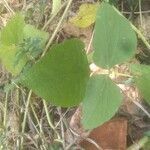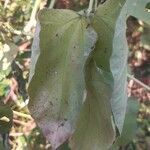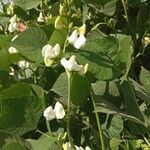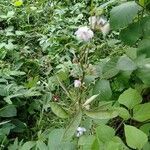Climbing or sometimes (outside the Flora Zambesiaca area or in cultivated plants) erect perennial (rarely annual) herb 1-6 m long. Stems pubescent or glabrous. Leaflets 2.5-15 x 1.5-14 cm, ovate-triangular, acuminate, cuneate to truncate at the base, glabrous or pubescent; petiole1-18 cm long; rhachis 0.7-4.5 cm long; petiolules 2-6 mm long; stipules 4-6 mm long, ovate, ribbed. Inflorescences axillary; rhachis 0.4-2 cm long; peduncle 2-40 cm long; pedicels 2-3.5 mm long; bracts 4 mm long, ovate-lanceolate, deciduous; bracteoles 4-6(8) x 1-4.5 mm, elliptic or round, ribbed, subpersistent. Calyx glabrous or pubescent; tube 3-4 mm long; lower lobes 2-4 mm long, triangular or linear-oblong, the upper pair joined to form an entire or emarginate lip. Standard entirely crimson or purple, or cream tinged mauve outside and purple inside, or all entirely white, 1.2-1.5 x 1.2-1.5 cm, oblate or round, glabrous; wings white or purple; keel pale, tinged mauve at the apex. Pods 3.5-14 x 1.2-4 cm, linear-oblong to oblong-falcate, often verrucose along the upper or both margins, pubescent or glabrescent but with very small dot-like tubercular hairs which are evident when the longer indumentum is sparse, 2-5-seeded. Seeds white or red to black, 5-17 x 4-6(9.5) x 3-5.5mm, oblong, compressed; aril 6-14 x 1.5-2 mm.
Climbing herbs; stems terete, strigose. Leaves trifoliolate, leaflets ovate to broadly rhomboid, 8.0-13.0 cm long, 6.5-12.5 cm wide, the lateral leaflets asym-metric, apically acute, basally cuneate to truncate; petioles 8.0-12.0 cm long, strigose; petiolules 2.5-3.0 cm long, strigose, stipels linear, 4.0 mm long, the stipules lanceolate, 4.0-5.0 mm long, caducous. Inflorescences axillary racemes to 30.0 cm long; flowers 10-15 per rachis, fasicled in groups of 2-3 at tubercles on the rachis; peduncles 18.0-15.0 cm long, the pedicels short 0.3 cm long; bracts subtending the flowers ovate, 3.0 mm long, 2.0 mm wide, strigose, caducous. Flowers with the calyx campanulate, 6.0-8.0 mm long, the lobes 2.5-3.0 mm long, upper 2 lobes fused; corolla white to purple, standard obovate, auriculate with 2 callosites running along the inner face, 1.5 cm long, 1.2 cm wide, the wings oblong to obovate, 1.5 cm long, 1.0 cm wide, the keel falcate, 1.5 cm long, 0.4 cm wide; stamens 1.5 cm long; style 1.3-1.5 cm long curved, flattened, the stigma capitate. Fruits broadly oblong, 5.2-8.0 cm long, 1.5-2.5 cm wide, strigose, the beak falcate, 1.0-1.5 cm long; seeds ovoid, 3-5, 1.3 cm long, 0.8 cm wide, the hilum oblong with white aril.
A climbing bean which can have vines 1-5 m long. It keeps growing from year to year. The stems can be smooth or hairy. Leaves are made up of 3 almost triangular leaflets. The leaflets are 5-15 cm long and 3-14 cm wide. The side leaflets are somewhat asymmetrical. Often the plants are flushed purple. The flowering clusters are 5-20 cm long. Flowers are often white but can vary from red to blue. The pods are flattened, pointed and up to 12 cm long and 2 cm wide. They can be green, purple or white. Inside there are 3-5 white or dark seeds. Seed pods have a wavy margin. The seeds are 0.5-1.5 cm long. (This bean is similar to Lima bean but the keel of the flower in not spirally twisted, the pod ends more bluntly with a long thin style at the end and the hilum on the seed is longer.)
Herbs, twining. Stems to 6 m, usually purplish. Stipules lanceolate; leaflets deltoid-ovate, 6-10 × 6-10 cm, lateral ones oblique, base subtruncate, apex acute or acuminate. Racemes axillary, erect, 15-25 cm. Flowers 2-5 clustered at each node. Calyx ca. 6 mm, upper 2 teeth wholly connate, lower 3 subequal. Corolla white or purple; standard orbicular, ca. 12 mm; wings with blade ca. 10 mm; keel base attenuate. Ovary linear; style longer than ovary. Legumes oblong-falcate, 5-7 × 1.4-1.8 cm, compressed, straight or slightly curved, beaked. Seeds 3-5, white, purple, or purple-black, oblong; hilum linear. Fl. Apr-Dec.
Perennial, climbing herb, 0.2-5.0 m long; stems pubescent or glabrous, entire plant often flushed purple. Leaflets ovate-triangular, 25-150 x 15-140 mm, acuminate, cuneate to truncate at base, glabrous or pubescent. Inflorescences: axillary racemes. Calyx: tube 3-4 mm long. Petals: standard crimson, partially purple or white; wings purple; keel pale tinged mauve. Pod linear oblong to oblong-falcate, 35-140 mm long, pubescent or glabrescent, tuberculate, 2-5-seeded. Seeds white or red to black.
Pods 3.5–14 × 1.2–4 cm, linear-oblong to oblong-falcate, often verrucose along the upper or both margins, pubescent or glabrescent but with very small dot-like tubercular hairs which are evident when the longer indumentum is sparse, 2–5-seeded.
Leaflets 2.5–15 × 1.5–14 cm, ovate-triangular, acuminate, cuneate to truncate at the base, glabrous or pubescent; petiole 1–18 cm long; rhachis 0.7–4.5 cm long; petiolules 2–6 mm long; stipules 4–6 mm long, ovate, ribbed.
Standard entirely crimson or purple, or cream tinged mauve outside and purple inside, or all entirely white, 1.2–1.5 × 1.2–1.5 cm, oblate or round, glabrous; wings white or purple; keel pale, tinged mauve at the apex.
Inflorescences axillary; rhachis 0.4–2 cm long; peduncle 2–40 cm long; pedicels 2–3.5 mm long; bracts 4 mm long, ovate-lanceolate, deciduous; bracteoles 4–6(8) × 1–4.5 mm, elliptic or round, ribbed, subpersistent.
Calyx glabrous or pubescent; tube 3–4 mm long; lower lobes 2–4 mm long, triangular or linear-oblong, the upper pair joined to form an entire or emarginate lip.
Climbing or sometimes (outside the Flora Zambesiaca area or in cultivated plants) erect perennial (rarely annual) herb 1–6 m long.
Seeds white or red to black, 5–17 × 4–6(9.5) × 3–5.5 mm, oblong, compressed; aril 6–14 × 1.5–2 mm.
Stems pubescent or glabrous.









